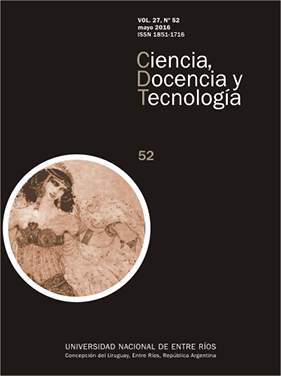Abstract
This paper presents significant aspects of the process of building the institutional web of a research institute in the field of Educational Sciences. The theoretical and methodological development framework was based on the perspective of Dynamic Hypermedia Device, following the deployment of work in collaborative networks, conditions of social inclusion, open access and implementation of open source technologies. The socio-technical approach allowed an organizational and technological co-construction according to the current physical-virtual academic context and technological and social bonding. The goal of the proposal could be guiding for other centers, since proposes a virtual architecture that integrates academic networking, navigation accessible and dynamic of institutional management.
References
BONGIOVANI, P.; GÓMEZ, N. y MIGUEL, S. (2012). Opiniones y hábitos de publicación en acceso abierto de los investigadores argentinos. Un estudio basado en los datos de la encuesta SOAP, en: Revista Española de Documentación Científica, 35(3): 453-467. Disponible en: < http://redc.revistas.csic.es/index.php/redc/article/view/752/833 > [3 de setiembre 2014].
BIJKER, W. (1995). Of bicycles, Bakelites, and Bulbs. Towards a Theory of Sociotechnical Change. Cambridge, Massachusets: MIT press.
BUKVOVA, H (2010). Studying Research Collaboration: A Literature Review, en: Sprouts: Working Papers on Information Systems, 10(3). Disponible en:<http://sprouts.aisnet.org/10-3 > [8 de agosto de 2011].
CARPENTIER, N. (2012) The concept of participation. If they have access and interact, do they really participate?, en: Revista Fronteiras – estudos midiáticos,14(2): 164-177.
CULLEN, C. (1997). Crítica de las razones de educar. Temas de filosofía de la educación. Buenos Aires: Paidós.
CHION, M. (1993). La audiovisión: introducción a un análisis
conjunto de la imagen y el sonido. Barcelona: Paidós.
FOUCAULT, M. (1983). El Discurso del Poder. México: Folios.
GARCÍA, R (2007) Sistemas complejos. Buenos Aires: Gedisa.
GONZÁLEZ, F. y VÁTTIMO, S. (2012). Procesos de inteligencia colectiva y colaborativa en el marco de tecnologías web 2.0: conceptos, problemas y aplicaciones, en: Anuario de investigaciones, 19(2): 273-281. Disponible en: < http://www.scielo.org.ar/pdf/anuinv/v19n2/v19n2a35.pdf > [10 de abril de 2015]
HARNAD, S.; BRODY, T.; VALLIERES, V.; CARR, L. & HITCHCOCK, S. (2008). The access/impact problem and the green and gold roads to open access: An update, en: Revista Serials Review, 34(1): 36-40.
OLSON, G.; ZIMMERMAN, A. & BOS, Nathan (2008). Scientific Collaboration on the Internet. Massachusetts: The MIT Press. Disponible en: < https://mitpress.mit.edu/books/scientific-collaboration-internet > [8 de agosto de 2014]
ORGANIZACIÓN DE NACIONES UNIDAS (2006). Convención sobre los derechos de las personas con discapacidad. Nueva York: Sede de las Naciones Unidas. Disponible en: < http://www.un.org/esa/socdev/enable/documents/tccconvs.pdf > [29 de abril de 2013]
RODRÍGUEZ, G. (2011). La teoría de los sistemas complejos aplicada al modelado del Dispositivo Hipermedial Dinámico. Tesis doctoral en Ingeniería. Universidad Nacional de Rosario. Disponible en < http://hdl.handle.net/2133/4226 > [7 de mayo de 2012]
ROMAÑACH, J. y LOBATO, M. (2005) “Diversidad funcional, nuevo término para la lucha por la dignidad en la diversidad del ser humano”. España: Foro de Vida Independiente. Disponible en:
< http://www.forovidaindependiente.org/files/documentos/pdf/diversidad_funcional.pdf > [3 de junio 2014]
SAITTA, C. (2002). La Banda Sonora. La Fábrica Audiovisual. Buenos Aires: Universidad Nacional de Buenos Aires.
SAN MARTÍN, P (2008). Hacia la construcción de un dispositivo hipermedial dinámico. Educación e investigación para el campo audiovisual interactivo. Bernal: Universidad Nacional de Quilmes.
SAN MARTÍN, P., ANDRÉS, G. Y RODRIGUEZ, G. (2014). Construir la memoria plural. Reflexiones acerca de una Comuna físico-virtual, en: La Trama de la Comunicación, 18: 211-229. Disponible en < http://www.latrama.fcpolit.unr.edu.ar/index.php/trama/article/view/476 > [30 de marzo de 2015]
SWAN, A. (2013). Directrices para Políticas de Desarrollo y Promoción del Acceso Abierto. Paris: UNESCO.
THOMAS, H.; FRESSOLI, M. y SANTOS, G. (2012). Tecnología, desarrollo y democracia: nueve estudios sobre dinámicas socio-técnicas de exclusión/inclusión social. Buenos Aires: Ministerio de Ciencia, Tecnología e Innovación Productiva de la Nación.
TRAVERSA, O (2011) Dispositivo-enunciación: en torno a sus modos de articularse. (pp. 17-29). En SAN MARTIN, P; TRAVERSA, O. (compiladores) El Dispositivo Hipermedial Dinámico Pantallas Críticas, I+D+I para la Formación Superior en Crítica y Difusión de las Artes. Buenos Aires: Santiago Arcos.
VERÓN, E. (2013). La semiosis social 2. Ideas, momentos, interpretantes. Buenos Aires: Paidós.
VILAS, C. M. (2012). El poder y la política. El contrapunto entre Razón y Pasiones. Buenos Aires: Editorial Biblos.
Legislación citada:
Ley de Accesibilidad de la información en las páginas web. Nº 26.653/10. Argentina. Disponible en: < http://www.infoleg.gov.ar/infolegInternet/anexos/175000-179999/175694/norma.htm > [29 de abril de 2013]
Ley de Creación de Repositorios Digitales Institucionales de Acceso Abierto, Propios o Compartidos. Nº 26899/13. Argentina. Disponible en: < http://repositorios.mincyt.gob.ar/recursos.php > [20 de febrero de 2014]
The authors retain the copyright and grant the journal the right to be the first publication of the work, as well as licensing it under a Creative Commons Attribution License that allows others to share the work with an acknowledgment of the authorship of the work and publication initial in this magazine. All content is published under the Creative Commons 4.0 international license: Attribution-Non-Commercial-Share Alike.

